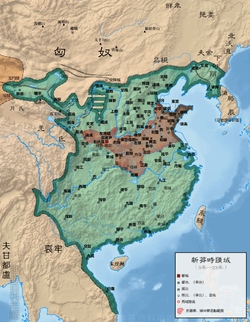Xin dynasty
| Xin dynasty | ||||||||||
| 新朝 | ||||||||||
| ||||||||||
 Xin dynasty (teal) | ||||||||||
| Capital | Chang'an | |||||||||
| Government | Monarchy | |||||||||
| Emperor | ||||||||||
| • | 9-23 | Wang Mang | ||||||||
| History | ||||||||||
| • | Wang Mang usurpation | 10 January[1] 9 | ||||||||
| • | Chang'an captured by Lülin | 5 October[2] 23 | ||||||||
| Currency | Chinese coin, gold, silver, tortoise shell, seashell | |||||||||
| ||||||||||
| Today part of | ||||||||||
The Xin dynasty (Chinese: 新朝; pinyin: Xīn Cháo; Wade–Giles: Hsin Ch'ao) was a Chinese dynasty (termed so despite having only one emperor) which lasted from 9 to 23 AD. It interrupted the Han dynasty, dividing it into the periods of the Western Han and the Eastern Han.
The sole emperor of the Xin dynasty, Wang Mang, was the nephew of Grand Empress Dowager Wang Zhengjun. After the death of her step-grandson Emperor Ai in 1 BC, Wang Mang rose to power. After several years of cultivating a personality cult, he finally proclaimed himself emperor in 9 AD. However, while a creative scholar and politician, he was an incompetent ruler, and his capital Chang'an was besieged by peasant rebels in 23 AD. He died in the siege, and the Han dynasty was restored by descendants of the former imperial clan.
| Personal name | Portrait | Period of reign | Era names and dates |
|---|---|---|---|
| Wang Mang | 9–23 AD |
Shijianguo (始建國 Shǐ Jìan Guó, "Start to establish a nation") 9–13 AD |
Notes
- ↑ Zizhi Tongjian, vol. 36.
- ↑ Zizhi Tongjian, vol. 39.
References
- Book of Han, vol. 99, parts 1, 2, 3.
- Zizhi Tongjian, vols. 36, 37, 38, 39.
- Yap, Joseph P. Wars With the Xiongnu - A translation from Zizhi tongjian Chapter 13–17 - pp 404–601 ISBN 978-1-4490-0605-1 (sc)
